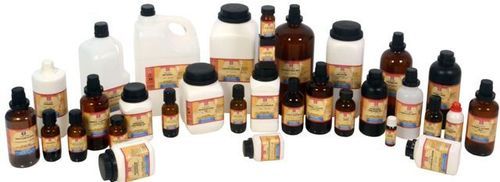क्लोरोएसिटाइल क्लोराइड
उत्पाद विवरण:
- उपयोग Lab Chemicals
- स्टोरेज निर्देश Dry Place
- ग्रेड Industrial
- टाइप करें
- एप्लीकेशन Lab Chemicals
- शुद्धता (%) 99.99
- अधिक देखने के लिए क्लिक करें
X
क्लोरोएसिटाइल क्लोराइड मूल्य और मात्रा
क्लोरोएसिटाइल क्लोराइड उत्पाद की विशेषताएं
- Lab Chemicals
- Lab Chemicals
- Industrial
- Dry Place
- 99.99
उत्पाद वर्णन
LC3158 Chloroacetyl chloride for synthesis Order number Packaging Quantity Price AC30158 Glass bottle 5 ml 10.89 AC30158 Glass bottle 250 ml 15.57 AC30158 Glass bottle 1 l 51.3 Product information Hill Formula C2H2Cl2O HS Code 2915 90 00 EC number 201-171-6 Molar mass 112.94g/mol Storage Store below +15C. EC index number 607-080-00-1 CAS number 79-04-9 Chemical and physical data Solubility (20C)(rigorous decomposition) Melting point -22.5C Molar mass 112.94g/mol Density 1.417g/cm3 (20C) Boiling point 105-110C (1013hPa) Vapor pressure 25.3hPa (20C) Refractive index 1.453 (20C, 589nm) Safety information according to GHS Hazard Statement(s) H301 + H311 + H331: Toxic if swallowed, in contact with skin or if inhaled.H314: Causes severe skin burns and eye damage.H372: Causes damage to organs through prolonged or repeated exposure if inhaled.H400: Very toxic to aquatic life.EUH014: Reacts violently with water.EUH029: Contact with water liberates toxic gas. Precautionary Statement(s) P280: Wear protective gloves/protective clothing/eye protection/face protection.P273: Avoid release to the environment.P302 + P352: IF ON SKIN: Wash with plenty of soap and water.P301 + P330 + P331: IF SWALLOWED: rinse mouth. Do NOT induce vomiting.P304 + P340: IF INHALED: Remove victim to fresh air and keep at rest in a position comfortable for breathing.P305 + P351 + P338: IF IN EYES: Rinse cautiously with water for several minutes. Remove contact lenses, if present and easy to do. Continue rinsing. Signal Word Danger Hazard Pictogram(s) RTECS AO6475000 Storage class Non combustible substances, toxic WGK WGK 3 highly water endangering Disposal 11Organic acid halides, anhydrides and isocyanates can be added dropwise to an excess of methanol (Cat. No. 822283) to convert them into the corresponding methyl esters or methyl carbamates. If necessary, neutralize with sodium hydroxide solution (Cat. No. 105587). Fill into container A. Safety information R Phrase R 14-29-23/24/25-35-48/23-50Reacts violently with water.Contact with water liberates toxic gas.Toxic by inhalation, in contact with skin and if swallowed.Causes severe burns.Toxic: danger of serious damage to health by prolonged exposure through inhalation.Very toxic to aquatic organisms. S Phrase S 7/8- 9-26-36/37/39-45-61Keep container tightly closed and dry.Keep container in a well-ventilated place.In case of contact with eyes, rinse immediately with plenty of water and seek medical advice.Wear suitable protective clothing, gloves and eye/face protection.In case of accident or if you feel unwell, seek medical advice immediately (show the label where possible).Avoid release to the environment. Refer to special instructions/ Safety data sheets. श्रेणियाँ of danger toxic, corrosive, dangerous for the environment Hazard Symbol Toxic Corrosive Dangerous for the environment Transport information Declaration (transport by sea) IMDG-Code UN 1752 CHLOROACETYL CHLORIDE, 6.1 (8), I, Segregation Group: 1 (Acids) Declaration (transport by air) IATA-DGR UN 1752 CHLOROACETYL CHLORIDE, 6.1 (8), Toxicological data LD 50 oral LD50 rat 120 mg/kg LD 50 dermal LD50 rat 662 mg/kg Specifications Assay (GC, area%) 98 % Density (d 20 C/ 4 C) 1.417 - 1.420 Identity (IR) passes testFAQs of Chloroacetyl chloride:
Q: What is the purity of Chloroacetyl chloride?
A: The purity of Chloroacetyl chloride is 99.99%.Q: What is the recommended storage condition for Chloroacetyl chloride?
A: Chloroacetyl chloride should be stored in a dry place.Q: What is the grade classification of Chloroacetyl chloride?
A: The grade classification of Chloroacetyl chloride is Industrial.Q: What is the primary application of Chloroacetyl chloride?
A: Chloroacetyl chloride is primarily used as a lab chemical.Q: What type of chemical is Chloroacetyl chloride?
A: Chloroacetyl chloride falls under the category of Industrial Lab Chemicals.Tell us about your requirement

Price: Â
Quantity
Select Unit
- 50
- 100
- 200
- 250
- 500
- 1000+
Additional detail
मोबाइल number
Email
Laboratory Chemicals अन्य उत्पाद
हम लैब केमिकल्स में सौदे कर रहे हैं।
“केवल 500ml तक के ऑर्डर स्वीकार करने वाले रिटेल सौदे”।
“केवल 500ml तक के ऑर्डर स्वीकार करने वाले रिटेल सौदे”।
 |
ALPHA CHEMIKA
सर्वाधिकार सुरक्षित.(उपयोग की शर्तें) इन्फोकॉम नेटवर्क प्राइवेट लिमिटेड . द्वारा विकसित एवं प्रबंधित |
 English
English Spanish
Spanish French
French German
German Italian
Italian Chinese (Simplified)
Chinese (Simplified) Japanese
Japanese Korean
Korean Arabic
Arabic Portuguese
Portuguese










